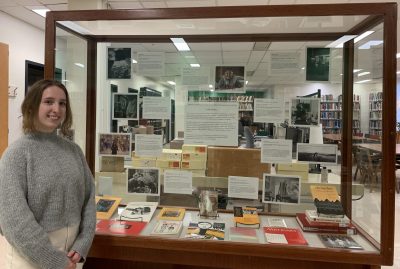 Over the course of two semesters, I had the opportunity to work in the Audio-Visual Resource Centre (AVRC) as a collections assistant. The AVRC holds an expansive collection of materials pertaining to Art History, Music, and Film Studies.
Over the course of two semesters, I had the opportunity to work in the Audio-Visual Resource Centre (AVRC) as a collections assistant. The AVRC holds an expansive collection of materials pertaining to Art History, Music, and Film Studies.
During my work term, I focused extensively on the organization and the display of the AVRC’s Archive of Canadian Women Artists (ACWA). The ACWA collection holds thousands of materials including exhibition catalogues, art journals, books, and other ephemera on hundreds of Canadian women artists. The collection, originally complied by Dr. Natalie Luckyj, spans approximately the 19th to the 20th centuries, with a focus on Canadian sculpture, folk art, and indigenous art.
To start, I produced a finding aid for the ACWA collection. The finding aid is a comprehensive and searchable document available to students who are interested in exploring the collection. Developing a finding aid provided me with a deepened understanding of the organization of archives, aiding the effectiveness of my own primary-source research.
Throughout my exploration of the archive to produce a finding aid, I noted images and objects of interest to formulate a theme for an exhibition of the archive. While surveying the materials, I gravitated towards images of artists in their studios. My exhibition, In the Studio, provides an intimate view of women who carved out their own spaces to work, with conventional and unconventional rooms of their own dedicated to their artistic practices. The exhibit provides a view of artists engaging directly with their works, putting faces to the names of Canadian women artists whose pivotal contributions of art began in the studio. The curation of In the Studio provided me the opportunity to connect with Canadian galleries, archives, and artists. The process gave me an in-depth understanding of the intricacies and challenges of starting with an archive and ending with its meaningful presentation.
Along with the two major projects of the finding aid and the exhibit, I determined the quality and sources of art images captured on 35mm slides in the AVRC’s 20th/21st century section of the collection. I removed and deaccessioned slides that were of poor quality and readily available elsewhere, providing space for the AVRC’s new acquisitions.
The Young Canada Works Program provided the opportunity to enrich my studies in the Master of Art and Architectural History program, allowing me to gain work experience that compliments my academic career.
Through my time at the AVRC, I learned that when looking for inspiration for academic projects, there is no shortage of exciting material on the fourth floor of the St Patrick’s Building.
I am grateful for this opportunity and for the AVRC team, who from the very start made the AVRC a welcoming place to work and to learn.